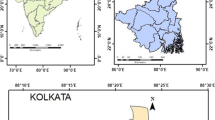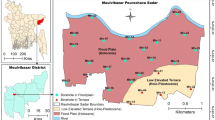Abstract
Benghazi city is the second largest city in Libya. Rapid and large infrastructural development and related economic activities in the last 20 years have mandated the use of Sabkha soils within the city limits for construction activities. There is a growing need to explore the geotechnical aspects of Sabkha soils including the liquefaction hazard. In this article liquefaction potential index (LPI) has been used for evaluating liquefaction hazards. Standard penetration test data from nearly 95 boreholes, located along the coastline of Benghazi city, has been used in the evaluation. The results of LPI analyses to investigate the surficial manifestations of liquefaction during 5.3, 6.5, and 7 magnitude earthquake scenarios for a peak ground acceleration of 0.18 g are presented in the form of a liquefaction hazard map for Sabkha soils of Benghazi. The map identifies 4 zones (A, B, C, and D) based on LPI. The results indicated that the LPI values of the Benghazi Sabkha deposits represent different levels of liquefaction severity for the above range of earthquake magnitudes. However, the Sabkha deposits displayed severe liquefaction susceptibility for earthquake magnitudes greater than 6. The results showed the severity from low to very high with LPI values ranging between 2 and 15. The results confirm the inherited depositional nature of mixed and layered deposits of Sabkha soils.









Similar content being viewed by others
References
Al-amoudi OSB (1999) Testing and stabilization of saline sabkha soils: a review. In: Proceedings of 6th international conference on case histories in geotechnical engineering, Arlington, Virginia, USA, Augast 4–9, pp 45
Kinsman DJJ, Park RK (1969) Studies of recent sedimentology and early diagenesis, Trucial Coast, Arabia Gulf. In: Proceedings of 2nd regional technical symposium society PTR. English AIME, Saudi Arabian Section
Hassan AH (1983) Seismicity of libya and related problems. Doctoral dissertation, Colorado State University
Kebeasy RM, Maamoun M, Albert RNH (1981) Earthquake activity and earthquake risk around the Alexandria area in Egypt. Acta Geophys Pol 29:37–48
Ambraseys N (1994) Material for the investigation of the seismicity of Libya. Libyan Stud 25:7–22. https://doi.org/10.1017/S0263718900006191
Suleiman AS, Albini P, Migliavacca P (2004) A short introduction to historical earthquakes in Libya. Ann Geophys 47:545–554
Al-Heety EA (2013) Seismicity and seismotectonics of Libya: As an example of intraplate environment. Arab J Geosci 6:193–204. https://doi.org/10.1007/S12517-011-0347-Y
Lagesse R, Free M (2017) Probabilistic seismic hazard assessment for Libya. In: Proceedings of 16th world conference on earthquake, 16WCEE. Santiago Chile
Hb S, Im I (1971) Simplified procedure for evaluating soil liquefaction potential. ASCE J Soil Mech Found Div 97:1249–1273. https://doi.org/10.1061/jsfeaq.0001662
Dixit J, Dewaikar DM, Jangid RS (2012) Assessment of liquefaction potential index for Mumbai city. Nat Hazards Earth Syst Sci 12:2759–2768. https://doi.org/10.5194/nhess-12-2759-2012
Iwasaki T, Tatsuoka F, Tokida K, Yasuda S (1978) A practical method for assessing soil liquefaction potential based on case studies at various sites in Japan. In: Proceedings the 2nd international conference of microzonation safer construction research application, San Francisco, California, USA, pp 885–896
Luna R, Frost JD (1998) Spatial liquefaction analysis system. J Comput Civ Eng 12:48–56. https://doi.org/10.1061/(asce)0887-3801(1998)12:1(48)
Sonmez H, Gokceoglu C (2005) A liquefaction severity index suggested for engineering practice. Environ Geol 48:81–91. https://doi.org/10.1007/s00254-005-1263-9
Toprak S, Holzer TL (2003) Liquefaction potential index: field assessment. J Geotech Geoenviron Eng 129:315–322. https://doi.org/10.1061/(asce)1090-0241(2003)129:4(315)
Bilsel H, Erhan G, Durgunoglu T (2010) Assessment of liquefaction/cyclic failure potential of alluvial deposits on the eastern coast of Cyprus. In: Proceedings of 5th international conference on recent advances in geotechnical earthquake engineering and soil dynamics, San Diego, California, USA, May 24th, pp 1–8
Farid ATM (2016) Probability of Liquefaction in Sabkha Soils under Different Earthquakes. In: Proceedings of Geo-China 2016, Shandong, China, July 25–27, pp. 183–190
Ahmed HR, Al Shayea NA (2017) Seismic behavior and zoning of the sabkha soils in Jubail industrial city, Saudi Arabia. J Seismol 21:1145–1169. https://doi.org/10.1007/s10950-017-9657-1
Mallick D, Morghem F (1977) Earthquake zoning of Libya. In: Proceedings of 6th World conference earthquake engineering, New Delhi, India, January 10–14, vol 1, pp 907–908
Global GIS : World faults. [Shapefile]. American Geological Institute. Retrieved from https://earthworks.stanford.edu/catalog/harvard-glb-faults. Accessed 8 Nov 2021
Mourabit T, Abou Elenean KM, Ayadi A et al (2014) Neo-deterministic seismic hazard assessment in North Africa. J Seismol 18:301–318. https://doi.org/10.1007/s10950-013-9375-2
Khan IH, Hasnain SI (1981) Engineering properties of sabkha soils in the benghazi plain and construction problems. Eng Geol 17:175–183. https://doi.org/10.1016/0013-7952(81)90082-X
Klen L (1974) Geological map of libya: Benghazi Sheet NI 34–14. State of LIbya. (Unpublished Report)
ASTM D2487 - 17e1 Standard practice for classification of soils for engineering purposes (unified soil classification system)
Cubrinovski M, Kenji I (1999) Empirical correlation between SPT N-value and relative density for sandy soils. Soils Found 39:61–71. https://doi.org/10.3208/sandf.39.5_61
Idriss IM, Boulanger RW (2003) Estimating Kα for use in evaluating cyclic resistance of sloping ground. In: The 8th US–Japan workshop on earthquake resistant design of lifeline facilities and countermeasures against liquefaction. pp 449–468
Idriss IM, Boulanger RW (2006) Semi-empirical procedures for evaluating liquefaction potential during earthquakes. Soil Dyn Earthq Eng 26:115–130. https://doi.org/10.1016/j.soildyn.2004.11.023
Idriss IM, Boulanger RW (2008) Soil Liquefaction during Earthquake. EERI Publication, Monograph MNO-12, Earthquake Engineering Research Institute, Oakland
Idriss IM, Boulanger RW (2010) SPT-based liquefaction triggering procedures. Rep. UCD/CGM-10, 2, 4-13
Boulanger RW, Idriss IM (2014) CPT and SPT based liquefaction triggering procedures. Cent Geotech Model 134
Seed HB, Tokimatsu K, Harder LF, Chung RM (1985) Influence of SPT procedures in soil liquefaction resistance evaluations. J Geotech Eng 111:1425–1445. https://doi.org/10.1061/(ASCE)0733-9410(1985)111:12(1425)
Skempton AW (1986) Standard penetration test procedures and the effects in sands of overburden pressure, relative density, particle size, ageing and overconsolidation. Geotechnique 36:425–447. https://doi.org/10.1680/geot.1986.36.3.425
Youd TL, Idriss IM (2001) Liquefaction Resistance of Soils: Summary Report from the 1996 NCEER and 1998 NCEER/NSF Workshops on Evaluation of Liquefaction Resistance of Soils. J Geotech Geoenvironmental Eng 127:297–313. https://doi.org/10.1061/(asce)1090-0241(2001)127:4(297)
Upadhyaya S, Green RA, Rodriguez-Marek A, Maurer BW (2019) Selecting factor of safety against liquefaction for design based on cost considerations. In: Proceedings of the 7th international conference on earthquake geotechnical engineering, Rome, Italy, June 17–20, pp 5419–5426
Cetin KO, Seed RB, Der Kiureghian A et al (2004) Standard penetration test-based probabilistic and deterministic assessment of seismic soil liquefaction potential. J Geotech Geoenviron Eng 130:1314–1340. https://doi.org/10.1061/(asce)1090-0241(2004)130:12(1314)
Seed HB, Idriss IM, Arango I (1983) Evaluation of liquefaction potential using field performance data. J Geotech Eng 109:458–482. https://doi.org/10.1061/(ASCE)0733-9410(1983)109:3(458)
Iwasaki T, K. I. Tokida FT, S. Watanabe SY, Hiroshi S (1982) Microzonation for soil liquefaction potential using simplified methods. In: 3rd international conference on microzonation, Seattle, USA, June 28-July 1, vol 3, No 2, pp 1310–1330
Oliveira CS (2006) The Influence of Scale on Microzonation and Impact Studies. In: Recent Advances in Earthquake Geotechnical Engineering and Microzonation. Springer, Dordrecht, pp 27–65. https://doi.org/10.1007/1-4020-2528-9_3
Acknowledgements
The authors would like to express their appreciation to Arabian Gulf Oil Company, El Sahel Engineering and testing Ltd., Libyan Technical Consultancy Company, for providing the borehole and geological data of different sites in the study area, as well as to Mr. Ali Shoeb, Dr. Abdelaziz Abuaziza, and Mr. Mohamed Shein for their support and help in this project.
Author information
Authors and Affiliations
Corresponding author
Additional information
Publisher's Note
Springer Nature remains neutral with regard to jurisdictional claims in published maps and institutional affiliations.
Rights and permissions
About this article
Cite this article
Miftah, A., Hussain, M. & Bilsel, H. Liquefaction Potential Index-Based Hazard Mapping for Benghazi Sabkha Deposits of Libya. Indian Geotech J 52, 1278–1291 (2022). https://doi.org/10.1007/s40098-022-00622-2
Received:
Accepted:
Published:
Issue Date:
DOI: https://doi.org/10.1007/s40098-022-00622-2




